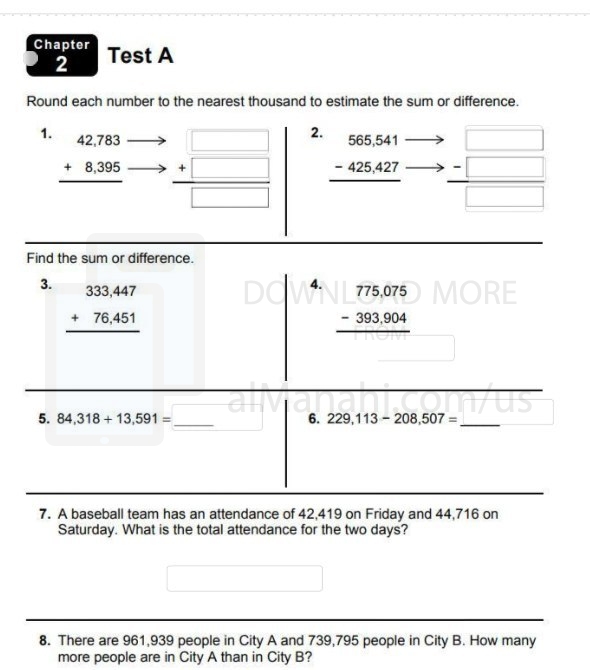File info: A Multi-Digit Addition and Subtraction Test is an assessment designed to evaluate students' proficiency in performing addition and subtraction operations with multi-digit numbers. The test typically includes a series of problems that require students to add and subtract numbers with multiple digits, including both whole numbers and decimals. The purpose of the test is to assess students' fluency, accuracy, and understanding of multi-digit addition and subtraction, and to identify any areas that may require further instruction or practice. Here's a description of what a Multi-Digit Addition and Subtraction Test might involve:
1. Format: The test is usually presented in a written format, with a set of problems that students need to solve on paper. The problems may be presented in a vertical format, where numbers are aligned according to place value, or in a horizontal format. The test may include both addition and subtraction problems, or it may focus on one operation depending on the specific objectives of the assessment.
2. Scope of Content: The test covers a range of addition and subtraction concepts and skills related to multi-digit numbers. This may include adding and subtracting numbers with two or more digits, regrouping or borrowing across place values, adding or subtracting decimals, and solving word problems that involve multi-step addition and subtraction operations.
3. Computational Skills: etThe test assesses students' computational skills in multi-digit addition and subtraction. It includes problems that require students to accurately add or subtract numbers with multiple digits, following the appropriate regrouping or borrowing procedures. The problems may vary in complexity, with some involving carrying or borrowing across multiple place values.
4. Estimation: The test may include problems that require students to estimate the sum or difference of multi-digit numbers before performing the actual calculation. This assesses students' ability to make reasonable estimates and check the reasonableness of their final answers.
5. Word Problems: The test incorporates word problems that require students to apply multi-digit addition and subtraction in real-life or mathematical contexts. These problems may involve situations such as calculating the total cost of several items, determining the difference in quantities, or solving multi-step problems that require multiple addition or subtraction operations.
6. Problem Solving: The test includes problems that require students to apply problem-solving strategies in multi-digit addition and subtraction. These problems may involve analyzing the given information, selecting the appropriate operation, and devising a solution plan. Students may need to decide whether to add or subtract, determine the necessary steps, and accurately execute the calculations.
7. Time Limit: The test is typically administered within a specific time frame to assess students' ability to work efficiently under time constraints. The duration of the test may vary depending on the grade level and complexity of the problems.
8. Grading and Evaluation: The test is scored based on the correctness and accuracy of students' solutions. The grading may take into account factors such as correct regrouping or borrowing procedures, accurate calculations, and appropriate labeling or notation. The test results provide feedback on students' individual strengths and areas for improvement in multi-digit addition and subtraction.
It's important to note that the specific content, format, and difficulty level of the Multi-Digit Addition and Subtraction Test can vary depending on the educational institution, curriculum, and grade level. The purpose of the test is to assess students' understanding and proficiency in multi-digit addition and subtraction, and to provide feedback to teachers, students, and parents regarding their mathematical skills and abilities in these operations. |
